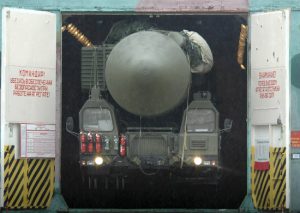Russian President Vladimir Putin in a speech on February 21, right before the first anniversary of the Russian invasion of Ukraine, said that Moscow is “suspending” its participation in the New START Treaty. However, suspension does not mean walking out of the treaty.
Putin also stated that Russia would strengthen its nuclear triad and deploy the Sarmat or “Satan II” Intercontinental Ballistic Missile (ICBM). Western media, quoting U.S. officials, said that the latest testing of the Sarmat missile had failed.
There is, however, a lot of mixed messaging. The Russian Foreign Ministry clarified that Putin’s decision to suspend Russian participation in the treaty was “reversible.” The Russian Foreign Ministry also added that it will stick to important commitments like providing notifications to the U.S. side on “launches of ICBMs (intercontinental ballistic missiles) and SLBMs (submarine-launched ballistic missiles)” and “quantitative restrictions on strategic offensive weapons.”
The New Strategic Arms Reduction Treaty (New START) came into effect in 2011 and was further extended in February 2021, just two days before the treaty was to expire. The Biden administration had just taken office, but the U.S. managed to secure the Russian extension of the treaty for another five years. Under the treaty commitments, the two countries are to limit their number of strategic nuclear warheads to 1,550 with additional restrictions on launchers – ground-based ballistic missiles, submarine-launched ballistic missiles and heavy bombers. This is essentially a reduction of warheads of about 75 percent compared to the number of warheads the two sides had at the end of the Cold War. According to Hans Kristensen, Russia has “nearly 4,500 warheads (plus 1,500 retired)” in which 1,000-2,000 are non-strategic weapons. The New START Treaty replaced the earlier SORT – Strategic Offensive Reduction Treaty, which expired in December 2012.
The New START treaty was the last surviving arms control agreements between the U.S. and Russia. In October 2018, President Donald Trump withdrew the U.S. from the Intermediate Range Nuclear Forces (INF) Treaty, which was in existence for three decades. The INF Treaty dealt with land-based missiles in the 500-5,500-kilometer range, but the U.S. was concerned about Russian violations of the treaty, especially regarding the range of SSC-8 “Screwdriver” cruise missile. In addition, the U.S. was also concerned that the treaty did not include China and limited the U.S. from deploying missiles to counter China’s intermediate range systems. China, of course, was not party to the INF Treaty.
Prior to that, the U.S. also withdrew from the Anti-Ballistic Missile (ABM) Treaty (1972) during the George W. Bush administration. As in the case of the INF Treaty, this was driven by the U.S. fear that the treaty limited U.S. efforts to respond to military capabilities that countries other than Russia were developing. Specifically, the U.S. felt threatened by the rapid development of long-range ballistic missiles by North Korea and Iran. From the perspective of the Bush administration, the ABM Treaty stood in the way of U.S. development of missile defenses to counter these new threats.
Russia’s suspension of its participation in the New START is unlikely to be a serious threat. It is more likely a sign of Russian displeasure at western support for Ukraine. The treaty itself expires in 2026. A more serious problem is whether Russia and the U.S. will be able to negotiate a follow-on treaty to succeed the New START Treaty. These treaties are complicated and can take years to negotiate, which means that it is difficult to expect a new follow-on treaty in the three years left. However, it is always possible that, as before, the New START Treaty can be extended for a period of time. Recall that the original treaty itself was valid only for 10 years. Thus, it is quite possible for the two parties to decide to further extend the treaty if they so desire.
However, there is one problem to be faced. Both the U.S. and Russia are concerned about China’s expanding nuclear arsenal. In a few years, China is likely to have close to 1,500 nuclear warheads, the limit that the New START Treaty has imposed on the U.S. and Russia (though this limit only includes warheads on strategic systems). Both countries would want to include China as part of any new treaty, but that would make the task much more difficult and complicated.
Putin’s withdrawal from the New START Treaty is unfortunate, but as yet, it is not a serious problem. However, the Russian invasion of Ukraine, China’s growing nuclear forces and the uncertain relationship between Russia, China, and the United States present a rather difficult problem for future strategic arms control.

































